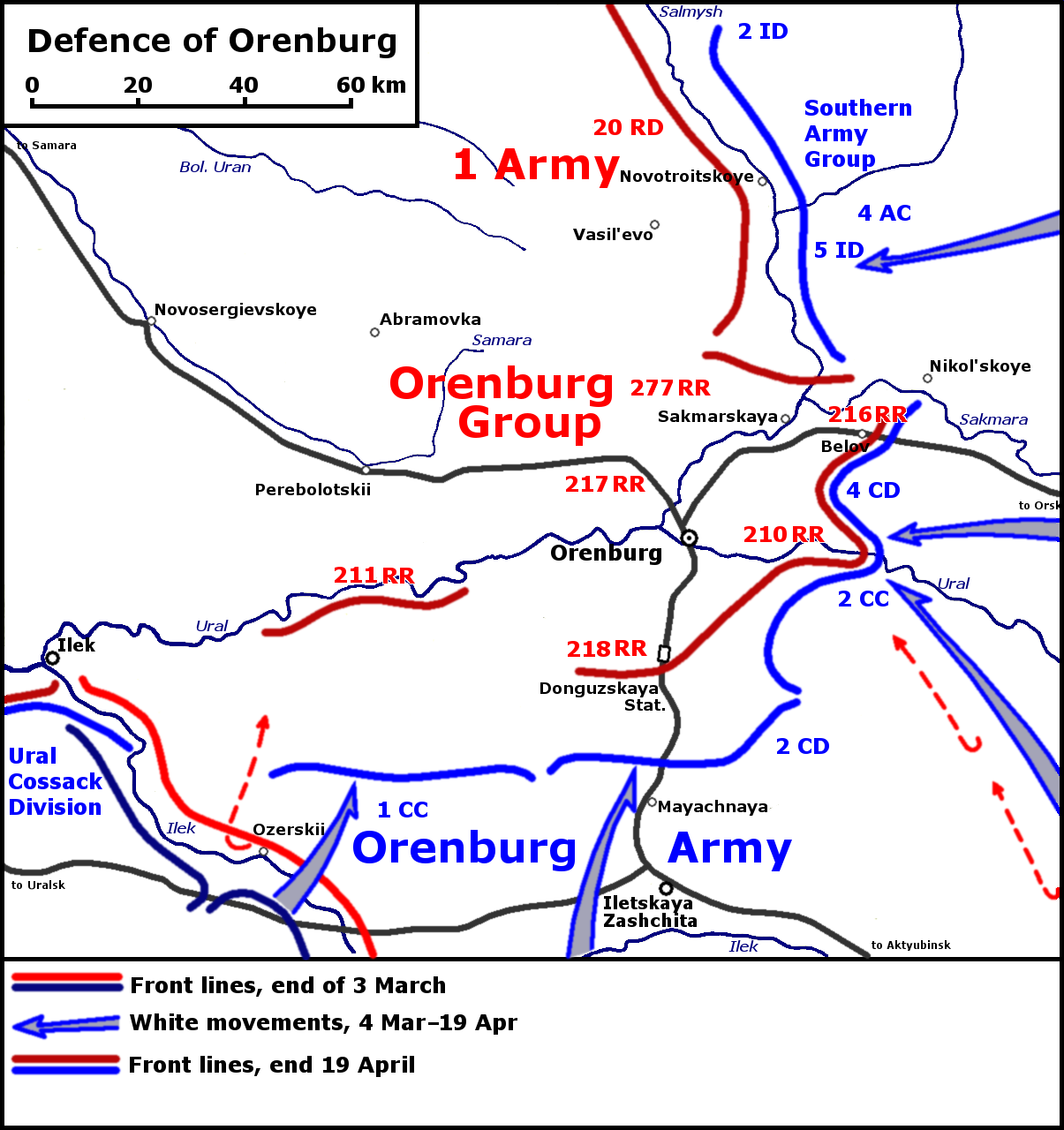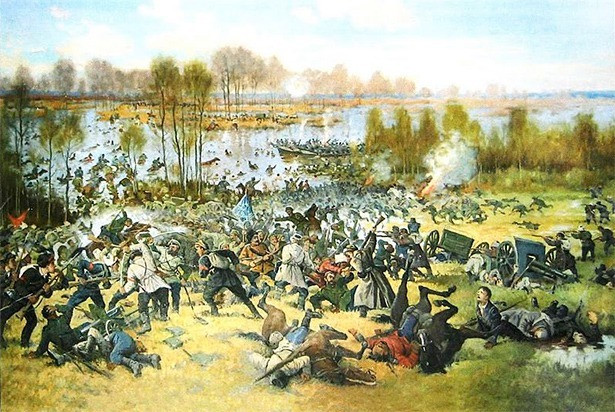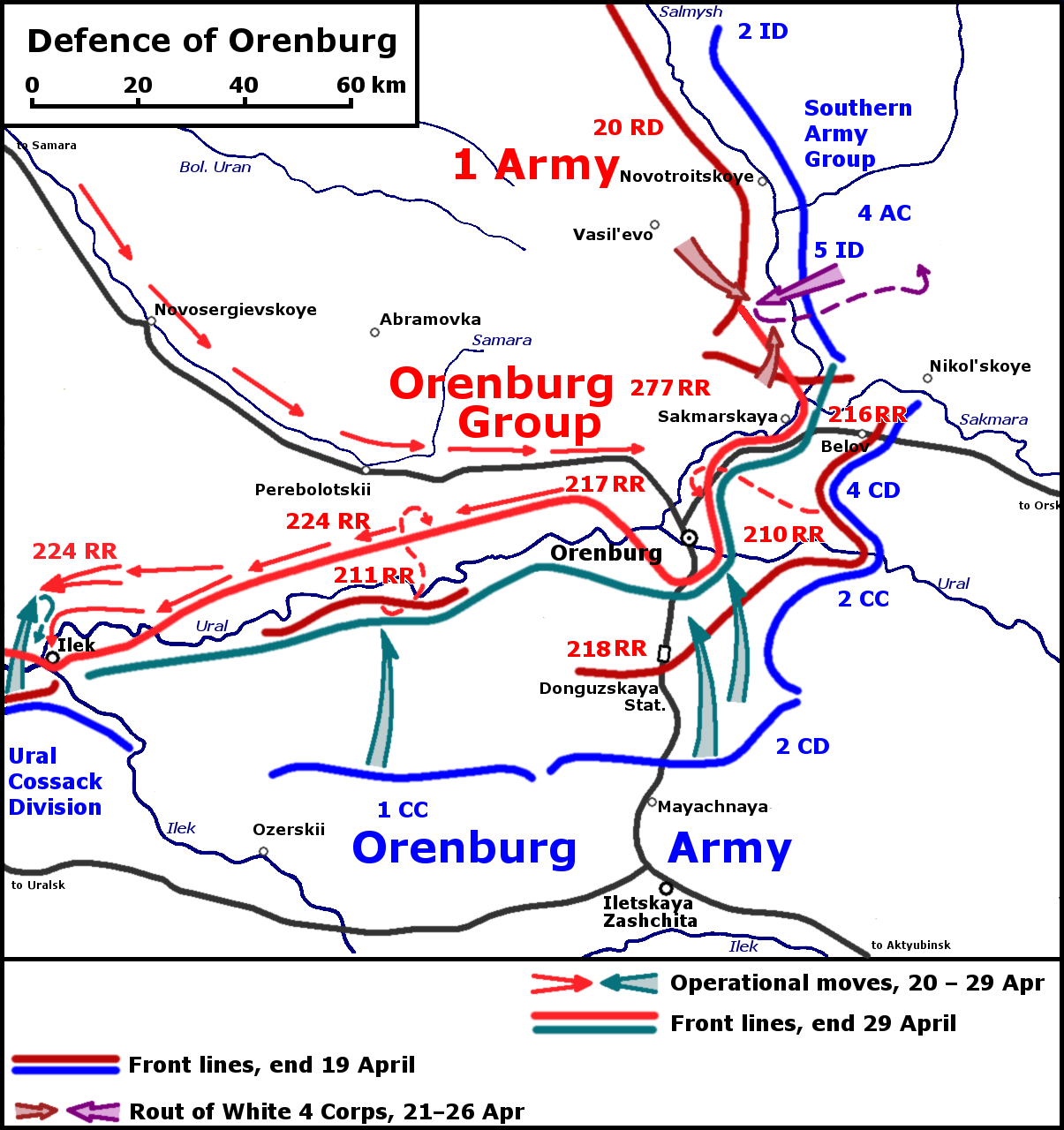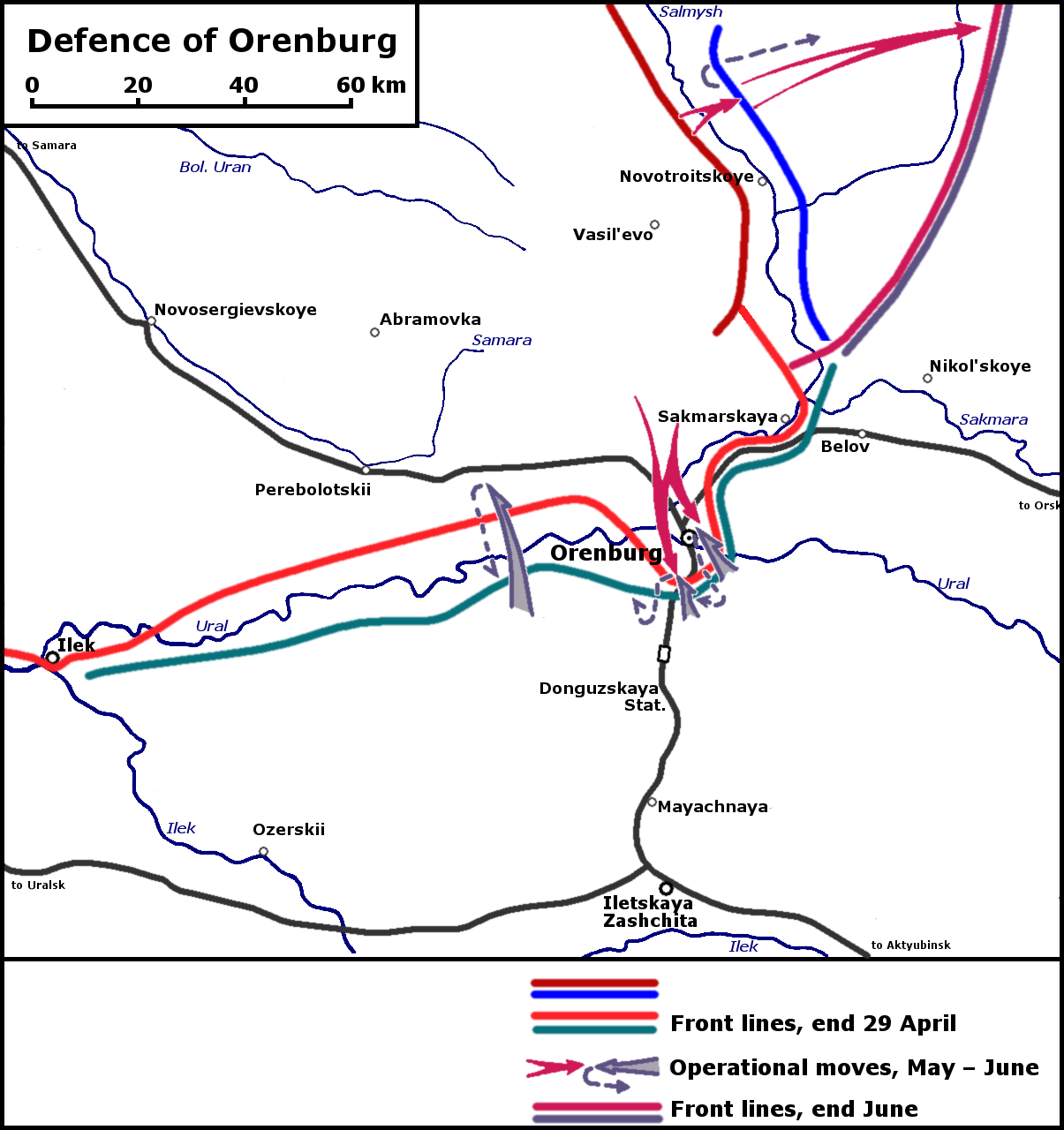
The Defence of Orenburg 1919
This is largely taken from Wikipedia (in Russian) and Futoryanski's "The Defense of Orenburg". The overview maps are from the Soviet "Encyclopedia of Civil and Intervention in the USSR". Those who want detail, including very good maps, should seek out V. F. Vorob'ev's "The Defence of Orenburg".
Ganin's biography of Bakich covers the operation from that general's point of view.
The Orenburg Operation, or the Defence of Orenburg in Soviet history, is the actions from April to June 1919 around Orenburg city during Kolchak's Summer Offensive.
It provides a lot of quite gameable scenarios. The text is only to give a general indication of the course of the fighting, as I haven't checked the information from the sources.
Background
In early April 1919 Kolchak's army attacked on a wide front, and was largely successful. On 4 April Sterlitamak was taken by parts of the Western Army and cities started to tumble. On 7 April, Belebei fell, on 10 April, Bugulma, and on 15 April, Buguruslan. It was important for the Whites to vigorously pursue the enemy, and in particular to seize strategic points, especially the crossings of the major rivers and the rail lines. In the southern section of the line, Orenburg was a key point.
The White command insisted on decisive action, and on 12 April 1919 the headquarters of the Supreme Commander directed the Independent Orenburg Army with taking Orenburg, Iletsk town and Aktobe. Any delay, thanks to the Spring flooding of the rivers, was equivalent to a defeat, and could permanently halt the Russian army progress. However, the Cossacks did not have sufficient superiority over the Bolshevik forces opposing them, and were particularly short on infantry. The 1st Orenburg Cossack Corps also had to conduct military operations on two fronts, advancing on Orenburg and Aktyubinsk. The White command, in this situation, was counting on surprise and the courage of the Cossacks. That is why many Cossack commanders personally led their troops into the attack, being on the front line under enemy fire.
Orenburg city was a major industrial centre, the capital of the Cossack host and a vital railway junction, with over 100 factories and plants. Its population in 1912 was 146,000. From a psychological point of view, it was also of fundamental importance to the Cossacks – the military capital of the Host and located in the middle of its territories. The desire for its possession was one reason many Cossacks participated in the struggle against the Bolsheviks .
The occupation of Orenburg would have opened the way for the White armies to move on Buzuluk and Samara and across the Volga. For the Reds, holding the city was key to the success of any subsequent counter-offensive. In the event of the city falling, the large cavalry groups of the Ural and Orenburg Cossacks, heading north from the line of the Ural River, could make deep raids into the rear areas of the Southern Army Group of the Soviet Eastern Front. The concentration area of the strike group Frunze was building for his counter-offensive (Buzuluk – Sorochinsky – Sharlyk) was just beyond the Orenburg district. The fall of Orenburg city would not allow Red to complete the strike force's concentration, so preventing it from going onto the counter-offensive against the Whites' Western Army while its rear was insecure from the south and southeast.
The Start of the Operation
On 6 April an appeal was made to " all workers, peasants and labouring Cossacks" to "join the ranks of fighters for the republic of workers". The formation of regiments began immediately and four regiments were formed from the 7,000 men who volunteered: the 210th (workers), 216th (peasants), 217th (mostly workers) and 218th (workers-peasants). The railway workshops alone provided 1,200, and the Orley Plant some 700. The entire village of Vasilyevka offered to join. Old men, women, teenagers served the rear of the city's defence (their hatred of Cossacks probably the main motivation, rather than their love of Soviet power).
When it became known that the Red Army was leaving the territory of Orsk district, a thirty mile line of peasant carts headed to Orenburg. Tens of thousands of peasants volunteered, but there was insufficient weapons and ammunition. Futoryanski records that at the same time, another unit was formed from labouring Orenburg Cossacks – the 4th Soviet Cossack regiment, numbering up to 3,000 according to him (but there is no indication the defenders had anything like this amount of cavalry, so I suspect the number of sabres was far lower.).
The first critical days in the defence of Orenburg were from 19 to 21 April, when Dutov tried to take the city by storm, from both south and east. On 19 April, he managed to capture Nezhinka, and in the afternoon they were only 5 km from the north-eastern part of the city. The next morning the Red regiments, under the commander of the defence, E.F.F. Vilumson, regained Nezhinka and entrenched themselves in their old positions. Wilumson was seriously wounded. Dutov's troops attacked again and broke into Nezhinka. The 216th Regiment was able to halt the attack, only three kilometres from the city.

By 20 April 1919 the city was the tip of a salient, pressed from two sides. White intelligence reports suggested the possibility that the Reds could leave the city without a fight, and indeed a full evacuation was in swing inside the city itself. However the Soviet leadership stressed the importance of retaining the city, and efforts to fortify it were redoubled. Citizens were pressed into digging trenches and laying wire, although many did so with extreme reluctance.
At this point the Bakich Corps attacked from the north, and fighting largely shifted to that sector. If the Cossacks and Bakich had been able to co-ordinate their attacks, the city may well have fallen.
Bakich Thrust
The troops of General Bakich (IV Orenburg Corps) reached the outskirts of Orenburg from the northeast at the confluence of the Salmysh and Sakmar rivers. Units of the Soviet 1st Army under G. D. Gai, which had retreated behind the Salmysh, bombarded the Bakich units with artillery and defended Orenburg's northern flank. The Reds in this area were largely parts of the 20th Penza Rifle Division under A. Ye. Vorobyov and the 31st Turkestan Rifle Division under A. D. Malyavinsky.
The Bakich Corps began to prepare a crossing of Salmysh in the spring flood.
On 18 April, the left-flank units of the 2nd Syzran Infantry Division, having crossed the Sakmara river, near the village of Nikolsky, took the villages of Upper and Lower Cheben'ki from the Reds.
On 20 April, the division occupied Sakmara stanitsa and began, to move successfully in the direction of the Seitovsky suburb to the north of Orenburg, in the Reds' rear. The appearance of the Russian army behind Salmysh was a complete surprise for Army-Commander Gai.
In the morning of 21 April, part of IV Corps began to cross the Salmysh in the area of Imangulovo and Bikkulovo and the village of Novo-Troitsky. The Whites managed to cut telephone communication from Orenburg to the headquarters of the 20th Penza Rifle Division. The 6th Syzran Infantry Regiment took Majorskaya village after a battle, from where it launched an attack on Kargala station, deep into the rear of the Red Orenburg Group. During the action of the 21st there was an annoying inconsistency in the actions of the Bakich and Akulinin Corps, which resulted in Bakich's 7th Khvalynsk Infantry Regiment halting its advance and returning to its original positions, when some of the men defected to the Reds.
On 22 April parts of the Bakich corps were shipped via the Salmysh from the Arkhipov farm, 7 kilometres east of Sakmara. Because of the strong flow of the river and the low carrying capacity of the ferry, the transit was delayed until 23 April, because of which the synchronization of the 2nd Division, which had broken into the rear of the Bolsheviks, and the 5th division, that was still completing its crossing, was disturbed. The 2nd Division took over 1,000 shells from the a Red Army wagon train near the village of Yekaterinovka, and the division continued its successful attack on Orenburg.
On 23 April IV Corps were given orders to cut the Orenburg–Samara railroad with cavalry, take Orenburg and, by 26 April, reach a line from Novosergievska to Nizhneozernoye. At 10 a.m. troops of the Russian Army occupied Sietovsky farm – which was to be the maximum success in the attack on Orenburg. Near the village Nizhnye Cheben'ki there was an engagement battle. The crossing of IV Corps in the northern sector of Imangulov did not go unnoticed by the Bolsheviks, who managed to halt it with the help of artillery. The crossing of the 5th Infantry Division also progressed extremely slowly due to damage to the ferry. By the end of the day, the command issued an order to build bridges over the edges of the already spilled Salmysh.
On 24 April, in accordance with orders to mop up the Bolsheviks between the Salmysh and Yangiz Rivers, which was meant to enable the 10th Verkhneuralsk Infantry Division to make its crossing near Bulanovsky, IV Corps waged a heavy battle for the crossing. The Reds attacked with overwhelming forces from south of Seitovskii and Sakmara stanitsa was abandoned by the whites. The 5th Division was forced to suspend its crossing.
On 25 April, seeing a slowdown in his corps' attack, Bakich moved his headquarters to the village of Imangulovo, located right on the front line, so he could direct the corps better. The 5th Infantry Division, having finished its crossing, began clearing the area between the Salmysh and Yangiz rivers of Reds. A second column led an attack on Sakmara village. The battle for the crossing near the Arkhipov hamlet was on-going. In the area of Imangulovo the Reds fought stubbornly, opposing the efforts of Bakich's soldiers to approach the crossing. The Russian Army also launched an attack by the 7th Infantry Regiment in the area of Verkhnye Cheben'ki village.
26 April was the decisive combat for the entire multi-month battle for Orenburg. The technical features of the ferry put in place the previous day precluded the possibility of a quick withdrawal in case the attack failed. Testifying later about the circumstances of the battle on this day, Colonel V. K. Neisel, commander of the 5th Infantry Division, noted:
... a withdrawal was not anticipated, and a retreat while under enemy attack could not be anything other than a catastrophe, so the order to attack was understood by me as a decisive bet – the breakthrough of the Red front and the capture of Orenburg, or the death of a division.
Under Soviet artillery fire, the Sakmara Horse Divizion conducted a crossing of the Salmysh, in the area of the Arkhipov farm, intending to take its native village – Sakmarskaya. The Bolsheviks grouped against Bakich's right flank, where the 5th Orenburg Infantry Brigade was fighting, and launched an attack against it with the support of 8 artillery pieces. The Reds included units of the 277th Orsk Rifle and 211st Cavalry Regiments of the 20th Rifle Division.
The Whites were forced to retreat, and the advancing reserves were crushed by those retreating – units began to surrender. A few officers of the 5th Division almost managed to save the situation and give the main mass of troops the opportunity to cross back over the river when, with a group of 150 soldiers, they attempted to halt the Reds. The Bolsheviks, who did not expect a counter-attack, began in their turn to retreat, but just as hand-to-hand was reached the infantry wavered and surrendered to the enemy. Neisel had no more reserves, and the Reds were able to approach the crossing and attack the ferry, shooting the men swimming from newly captured machine guns. During the hard battle, the Whites lost 200 people killed and up to 1,500 prisoners. The Reds captured 3 guns, 20 machine guns and 1,000 shells.
After the Whites crossed, many swimming under fire, they retreated to Sergievka village and Sukhomlinovsky farm. With the withdrawal of the last troops to the rear, the composite brigade of Colonel G. M. Faddeev was advanced from the corps reserve to fill the line. After this defeat, General Bakich was forced to suspend active operations by his corps against Orenburg.
On 27 April, the Bakich Corps headquarters was moved to the village of Novo-Nikotinskaya in the rear. The Bolsheviks crossed over to the left bank of Salmysh, forcing their way through the White defences with artillery and machine gun fire, but the Tatishchevsky Plastoon Divizion and the training command of the 2nd Syzran Infantry Division managed to repel the Red crossing.
On 29 April, the Reds again attacked the crossing at Arkhipov, but Bakich's troops let them close up to the crossing and then met them with heavy shelling. Subsequently, the Reds tried constantly to cross the Salmysh, but were not able.
On 30 April, in accordance with an order for the Southern Army Group, the Bakich Corps went on to the defensive.
In May, Bakich received an order to regroup and concentrate his forces towards Sterlitamak. In the remaining attacks on the city the corps had to play a passive role, simply keeping in touch with the Orenburg II Cossack Corps with the help of horse units.
The Salmysh Battles in Soviwt History
The battles on the Salmysh reached mythic proportions in Soviet historiography. There is a very famous painting of the battle taking place with the Whites fleeing by swimming across the flooded river.

While a decisive victory for the Red Army, the origins of the victory are somewhat disputed. Soviet historians alleged, that the Red Army's plan was to allow IV Corps to cross Salmysh, and then press it to the river and crush it. The modern historian of the civil war in the Orenburg region, A. V. Ganin, says that this was wishful thinking on the part of those Soviet historians, since up to 23 April the initiative for the Orenburg operation was completely in White hands. The Whites over-extended and were badly co-ordinated, which allowed a riposte, but Orenburg was in far too much danger for the Soviets to actually allow a crossing to take place voluntarily.
If Bakich had been able to co-ordinate his actions with the Cossacks directly to his south, and if the crossing had been managed a bit better, the city may well have been totally surrounded, and might even have fallen to Bakich's men. (Throughout the war the Cossack armies proved incapable of storming fortified cities, being short on both the regular infantry and proper artillery required.)

The revisionism extends to the mapping of the battle. The above map, which is taken from the Soviet Encyclopedia of Civil War and Intervention shows the penetration of the 5th ID as both far too high and far too limited. The decisive fighting was some 20 km further south of where shown, and the threat to the city much greater than that maps makes it look, with the most advanced White units reaching almost to the northern suburbs of Orenburg.
Attack from the Orenburg Cossacks
During this time, the I and II Cossack corps advanced somewhat on the southern and eastern approaches to Orenburg, taking advantage of the fact that significant forces of the Reds were deployed north of the city. On 29 April I Corps even captured Menov Yard, just 5 km south of Orenburg, and fired on the city with artillery.
The defence was the "Orenburg Group", which included: the 277th Orsk infantry regiment of the 31st Division, the 211st regiment of the 24th Division, the first brigade of the 3rd Cavalry Division, the 224th Rifle Regiment (defending Iletsk), 210th, 216th, 217th and 218th Regiments. The commander was M. D. Velikanov, and the commissar was A. A. Korostelev. It should be noted that the Red forces held a significant advantage in equipment and technical support.
We have an order of battle for the Orenburg Group for the middle of April 1919 in Vorob'ev's book, citing Red Army Archives.
| Unit | Listed | Bayonets | MGs | Guns | Cav Sq |
|---|---|---|---|---|---|
| 210th Orenburg Regiment | 1,124 | 1,112 | 12 | 2 | 2 |
| 216th Rifle Regiment | 2,700 | 1,580 | 17 | 2 | 2 |
| 217th Orenburg Regiment | 2,429 | 2,082 | 6 | – | – |
| 218th Orenburg Regiment | 2,000 | 1,542 | 5 | – | – |
| 277th Orsk Regiment | 2,925 | 2,500 | 38 | 3 | – |
| Independent Cavalry Divizion | 140 | sabres | – | – |
224th Rifle Regiment defending Iletsk Gorodok at this time.
The cavalry squadrons shown are from the 4th Cavalry Regiment.
The White forces can be found here.
The main battles were fought over the only railway bridge in the region across the Ural River, but the Reds were able to hold it throughout.
On 2 May 2 Kolchak demanded: "... all Bolshevik troops in the region of Samara – Orenburg – Uralsk – are to be surrounded and destroyed". On 8 May 8, the whites moved to attack again: Dutov's I Corps were to the south of the city and II Corps to the East. The Cossacks approached Grebeni and the Sakmara crossing. The battles were particularly bloody. In the south, the Whites advanced to the Menov Yard. The 217th regiment, made up of Orlek workers, suffered huge losses.
A few days later the city was almost completely surrounded, the Whites being aided by the revolt of many villages in the rear of the Reds. Pravda then reported: "As a result of the fighting, our units destroyed the bridge over the Ural River near Orenburg and retreated to the right bank. The Orenburg station is being shelled by the enemy's artillery", the city's defenders did not have any reserves. Orenburg was burning in several places on the night of May 14-15. Movement from the centre of town to the Ural River was highly dangerous. On 15, 16 and 17 May the Cossacks continued to attack the city on all sectors.
Reinforcements now arrived however for the Reds, which allowed the Orenburg Group to go onto the offensive. The Whites were knocked out of the Belov farm, Nizhny Cheben'ki and Nezhinska village.
On the night of 21-22 May the 217th regiment cleared the White Cossacks from Belov with a surprise attack. However, the Whites, still being 10-20 km from the city, continued its artillery bombardment from Sulak Mountain.

But the White attack had run out of steam. From this point on the Orenburg Cossacks began to see increasing defections to the enemy.
The fighting had been quite intense. In just a month of fighting for Orenburg, about 3,600 were wounded and over 800 soldiers and commanders of the Red Army were killed.
On 23 May, the Kolchak decided to disband the Separate Orenburg Army, and it went instead into the Southern Army, under Major-General Belov . This army was tasked with reaching the Orenburg–Buzuluk–Samara line to stop the Bolsheviks' offensive against the Western Army.
By mid-June, General Belov had again reached the outskirts of Orenburg. By this point though the initiative was no longer with the Whites. In July the Southern Army ceased active steps in the direction of Orenburg. And in August 1919, during the Soviet Aktobe operation, the Cossacks were forced to move away from the city, thus forever lost hope of regaining the Cossack capital.
